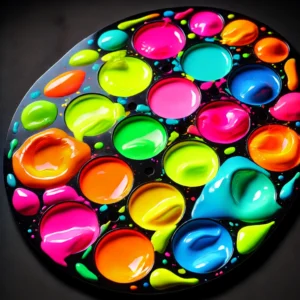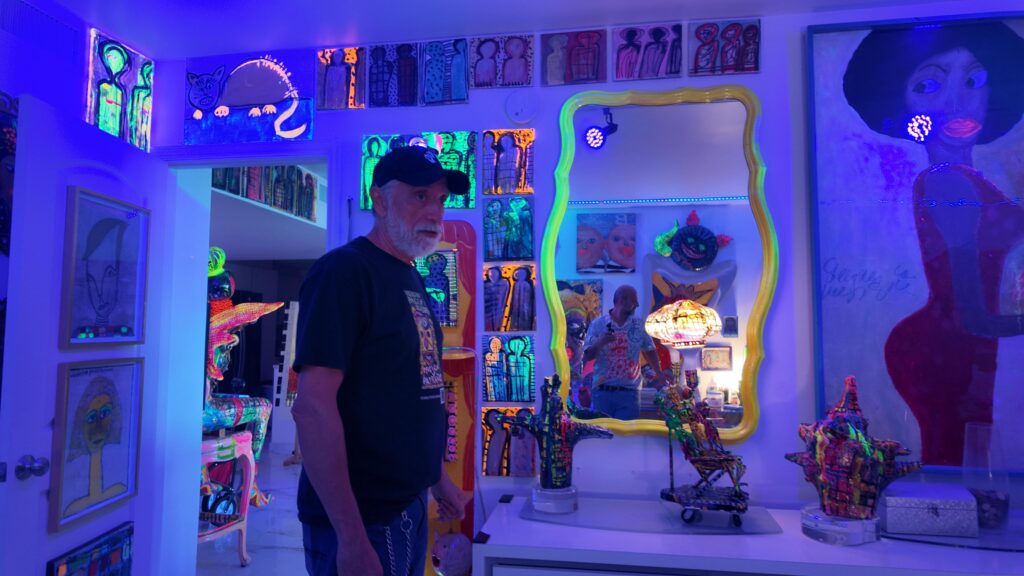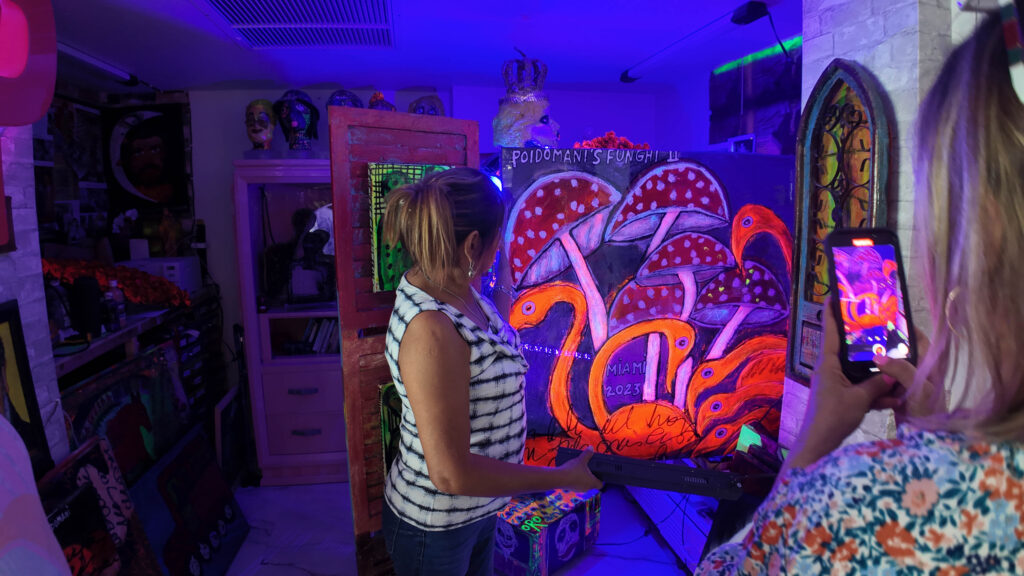Introduction to Black Light Art and Fluorescent Light
Blacklight: Black lights emit ultraviolet (UV) radiation, which is not visible to the naked eye but can make certain materials glow. These materials include fluorescent paints and pigments, which absorb UV light and re-emit it as visible light, making them a critical part of black light art.
Fluorescent light: Though part of the visible spectrum, this type of light can also interact with certain fluorescent paints, highlighting and enhancing particular colors, especially in black light art.
Historical Context
UV light in black light art became popular during the mid-20th century, especially in psychedelic art movements, where artists wanted to create visually dynamic experiences. The practice is also seen in street art, contemporary installations, and experimental gallery spaces. These spaces often featured glowing artworks, fully embracing the potential of UV light.

Fluorescent and UV-responsive Pigments
Fluorescent paints contain pigments that absorb UV light and emit visible light, creating the unique glowing effect central to black light art. Acrylic paints with these pigments can enhance the visual experience under UV light.
Daylight fluorescent pigments are visible under normal light but become more vibrant when exposed to UV or black light. They are often used to create striking contrasts.
These paints contain specific chemicals that react to UV exposure, such as zinc sulfide or cadmium sulfide. These chemicals produce bright, glowing effects that are iconic in black light art installations.
How Black Light Affects Acrylic Paintings
Black light art relies on the effect of UV light on fluorescent acrylic paints. Under black light, these paints glow vividly, making some aspects of the painting “pop” while non-fluorescent areas remain unaffected, creating a sharp contrast. This interplay between fluorescent and non-fluorescent areas is a key characteristic of black light art.
UV light can also highlight texture and surface treatments in paintings, revealing details that may not be easily visible under normal lighting conditions. However, continuous exposure to UV light can fade certain pigments, particularly organic dyes, which is a concern when creating long-lasting black light art pieces.

Applications in Art
Interactive art installations frequently employ black light art techniques, allowing viewers to experience the duality of normal and UV lighting. Humberto Poidomani, known for his sculptures, assemblages, and installations, might find the interplay between lighting modes particularly intriguing, enhancing his complex narratives.
In movements like psychedelic and street art, artists used black light art to push the boundaries of visual perception, especially in large-scale murals and graffiti, where glowing elements captivated the viewer’s eye.
Aesthetic and Ideological Uses in Contemporary Art
Black light art can amplify contrasts and ideological tensions in works dealing with themes such as ecology, social crises, and life and death. For artists like Poidomani, exploring the effects of UV light on certain found industrial materials or reused objects could give his works a different symbolic resonance, illuminating the “hidden” aspects of modern life and decay.
As a metaphor for hidden truths, black light art reveals concealed aspects of reality, resonating with Poidomani’s critical view of societal issues.
Questions relatives à la conservation et à la préservation
While black light art creates striking visual effects, continuous exposure to UV light can degrade materials over time. This phenomenon concerns artists like Poidomani, who use non-traditional materials such as found objects. Some materials, especially organic ones, can become brittle or discolored when exposed to UV light for extended periods.
To preserve art, curators and collectionneurs d'art shield pieces from prolonged UV exposure during storage or display, especially when using fluorescent pigments, which are more sensitive to light degradation. This practice is essential for those making investissements artistiques, as protecting a piece’s longevity enhances its value and ensures it remains a worthwhile investment over time.
Black Light in Exhibitions
Museums and galleries often use black light art to create dynamic exhibitions. In the case of Poidomani’s exhibitions, displaying select pieces under black light could create a multi-layered viewing experience, where elements of the work come alive under different lighting conditions. This technique enhances the viewer’s emotional response, drawing them into a more immersive environment.
Scientific and Technical Considerations
Black light art benefits from the technical aspects of luminescence and UV fluorescence, where UV photons excite electrons in fluorescent pigments, causing them to emit visible light. Modern art techniques can also use this scientific mechanism to reveal invisible details in artworks under standard lighting conditions.
For artists like Poidomani, the technical depth of black light art adds another layer to the narrative, as these hidden elements can symbolize the concealed or forgotten aspects of modern life. This approach adds meaning and engagement for the viewer.
The Symbolic Use of Light in Art
Historically, artists have used light to symbolize divinity, knowledge, or revelation. However, black light artists invert this concept by using darkness to reveal what is hidden.
For Poidomani, whose works delve into ideological themes like poverty and societal fragmentation, black light art can deepen the symbolic interplay, casting light on marginalized or forgotten aspects of the human condition.
Conclusion
In conclusion, black and fluorescent light art offers unique opportunities to enhance visual effects and symbolic meanings in acrylic paintings. Humberto Poidomani, with his bold, ideological themes and innovative use of materials, could explore these lighting techniques to push the boundaries of his art further. His installations and sculptures could take on new layers of meaning and interaction, resonating with his critical view of modern society. Additionally, considerations around preservation, exhibition, and audience engagement make black light art an exciting frontier in contemporary art, both technically and ideologically.

